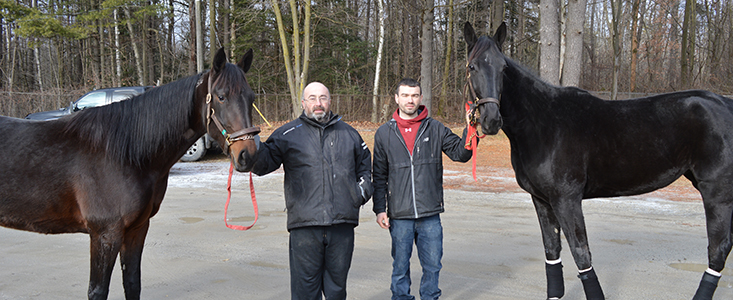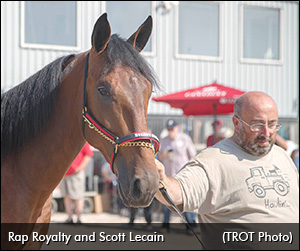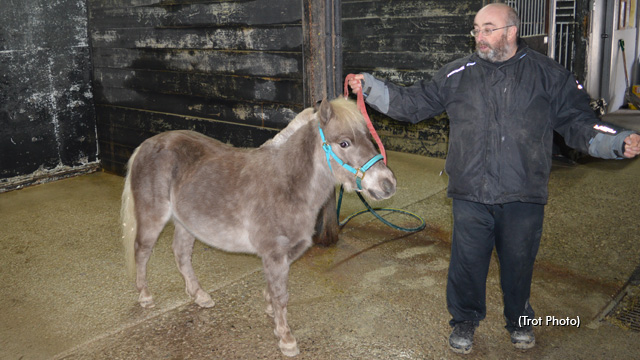In the early morning hours of December 21st, Scott Lecain was awoken by a phone call; Trevor Forgie by a frantic banging on his door - something that rarely means good news.
Mere minutes later, both men were risking their lives, pulling their beloved horses out of a burning barn. By Dan Fisher

Make no mistake about it, when you speak to either Scott Lecain or Trevor Forgie, they’re not looking for adoration from anyone, or to be celebrated in any way. In fact, when CTV News called Scott and asked him for an interview, Scott sent them a message back through a friend and asked them where they were last summer with their coverage of the Metro Pace or the Canadian Pacing Derby? He told them that if they wanted to start covering the positive happenings of our great sport, that maybe next time there was a tragedy, God-forbid that it ever happen again, that the people involved might share their story with them. For now, Scott decided that he’d just keep it to himself.
 Most people in the industry know by now, that in the early morning hours of December 21, there was a horrible barn fire in the Mark Steacy Stable, at the First Line Training Centre, located just outside of Guelph, Ontario. There were 37 horses, a pony and a cat residing in that barn at the time, and thanks to people like Scott and Trevor, along with Steve and Rebecca Titus, Joe Stutzman, and multiple firefighters, 32 of the horses, the pony and the cat survived. Racehorses, Pearl Blue Chip, Mademoiselle Tammy, Rap Royalty, Miss Wheely and Irma did not.
Most people in the industry know by now, that in the early morning hours of December 21, there was a horrible barn fire in the Mark Steacy Stable, at the First Line Training Centre, located just outside of Guelph, Ontario. There were 37 horses, a pony and a cat residing in that barn at the time, and thanks to people like Scott and Trevor, along with Steve and Rebecca Titus, Joe Stutzman, and multiple firefighters, 32 of the horses, the pony and the cat survived. Racehorses, Pearl Blue Chip, Mademoiselle Tammy, Rap Royalty, Miss Wheely and Irma did not.
“Joe [Stutzman] banged on my door and woke me up,” recalls Forgie, 29, who is a member of the Ottawa-area Forgie family, and has worked for the Steacy outfit for approximately a year-and-a-half. “It was about 1:30 in the morning I think, I was asleep in my trailer [not far from the barn] and hadn’t heard a thing. I got dressed as quickly as I could and when I ran outside, all I could see was giant flames coming out of the roof of the barn. I got around to the one door and Scotty [Lecain] was coming out of the smoke-filled barn with a horse. He passed it off to me and told me to take it somewhere quickly and come back, and he’d try to get another one.”
Lecain, 49, is a second-trainer, and caretaker in the Steacy Stable, and has worked in the industry for many years as a groom and assistant trainer for different people including Riina Rekila, Dave Tingley and Bill Gale.
“I got a call from Mark [Steacy]. I guess when Hughie [Fitzpatrick] heard the explosion, he woke Joe. Joe called 911, and then called Mark, who called me. I got dressed and flew over to the farm from my place in Rockwood. It’s usually a 10 minute drive, but I literally made it in 5 or 6 minutes. There’s a small town that I pass through on the drive, where the speed limit is 40 km/h - I was doing 140 through there. When I pulled in, the firefighters had just arrived. The one fella at the end where I was told me not to go in. Ya, right. When I told him that I was [going in] he told me that he had no experience with horses, but that he could take care of me. The barn was just full of black smoke, you couldn’t see a thing - so he grabbed the back of my coat and said, ‘You go in. I’ve got you. But if we get into trouble I’m pulling you out… I can get you out.’ So I put my sweater over my nose and mouth and we went in. I just went by feel. I knew where the gates were - where the latches were - where the halters hung. We got Hello Love out first, and got her to safety. I got my daughter’s pony [Toby] out quickly as he’s right close to the door. We got another one out as well, and then I saw Trevor. That helped because now I only had to get them to him, and he could then take them to a paddock, or another barn, while I went back in for another horse. That firefighter just held on to me. He kept coming in with me, holding my coat and promising me he’d get me out if he needed to. So he and Trevor and I worked like an assembly line - I’d bring one out, and Trevor would run them to safety and come back for another.”

Toby and Scott Lecain
Apparently, as this was going on at one door, a similar experience was taking place at the other end of the barn. As Forgie tells it, “By luck, Riley McGilloway was one of the firefighters working on the crew that had arrived to fight the fire.” McGilloway has worked in the industry in the past, and was a huge help to the group at the other end of the burning barn. “Riley, and Steve and Rebecca Titus were pulling horses out at the other end of the barn. It was great that Riley had the experience with horses… all of the firefighters were great, and they were helping the best they could at our end too, but they didn’t even know how to put halters on. A few of the horses that were passed off to me had the noseband in their mouth, and maybe just one ear inside of the halter… things like that. I remember just holding on tight as I ran them to safety, and hoping that the halters would just stay on. Joe was yelling directions to me - like, where a barn was that had an empty stall, or what paddocks were still empty. We were mindful enough to keep putting mares and geldings out in the paddocks together, separate from studs - things like that. It was pretty chaotic, but we were still being pretty organized. And the horses, they all remained pretty calm… I really couldn’t believe it. The ones in their stalls sounded a bit panicky maybe, but as I was leading them around and taking them to safety, they were all pretty calm. You could tell that they knew we were helping them.”
And help them, they did - to say the least.
Forgie couldn’t say how much time had elapsed from the time he awoke, until the last horse had been rescued - possibly about 30-40 minutes he guesses. But when all was said-and-done, everyone involved realized that it could have been so much worse, if not for the bravery of all the individuals on the scene.
And what comes next? What does the future hold in store for the surviving horses? “We’re stabled in the backstretch at Mohawk until the spring, it looks like,” shares Lecain. “That was really nice of the people at WEG to let us do that. We took a bunch of the horses that were wheezing a bit, or didn’t seem to be breathing quite right, to the university [of Guelph]. They’re all back here now, and are jogging again . They put them in the oxygen [hyperbaric] chamber there and it seems to have helped them. But you really don’t know until they get training down, and racing again, if they’ll still be able to compete at the same levels as before. Two of the mares that were going to be bred in the spring anyway have gone to the farm - no sense training them back down now, when they’re just going to be bred in a few months. What really stands out to me after all of this is all of the help and support that we’ve received from everyone in the industry… it’s been really great,” says Lecain with a smile.
Toby, the pony, has settled in a Mohawk with the rest of the horses too, but as for the cat, what happened to him?
Ironically enough, the cat that lived in the Steacy barn, goes by the name of Smokey, and the Steacy crew didn’t want to bring him to Mohawk in fear of him wandering off from his new surroundings and getting lost. “I’ve got Smokey living with me,” tells Forgie. “After working with us for some time, my girlfriend Emily [Veinot] had gone to Florida for the winter to work for Casie Coleman. After hearing of the fire she moved back here right away and started working for us again - she just wanted to be here with the rest of us after what we were all going through. In the aftermath of everything there was no way to get electricity to our trailer at the farm, so kind of lost our home too,” said Trevor with a sheepish grin. “So Emily and I [and Smokey] found an apartment. We’ll keep him there with us until the barn has been rebuilt.”
Scott. Trevor. Emily. Smokey. Riley. Woodbine Entertainment. Steve. Rebecca. Joe. Toby. The firefighters. And so-on-and-so-on, in case we’ve left anyone out - Cheers to all of you!
Just more prime examples in our wonderful business, of people and animals taking care of each other, especially when it’s needed the most.


